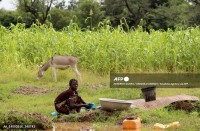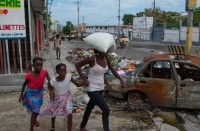
By Tanya WILLMER
NAIROBI, May 4, 2024 (AFP) – Coastal regions of Kenya and Tanzania were buffeted by heavy rains and high winds from a tropical cyclone on Saturday, adding to the chaos caused by deadly floods that have ravaged the region.
More than 400 people have lost their lives across East Africa and tens of thousands have been uprooted from their homes in recent weeks as torrential rains triggered flooding and landslides that engulfed houses, roads and bridges.
The Kenya Met Department said in a bulletin on Saturday that the effects of Tropical Cyclone Hidaya were already being felt offshore, with strong winds exceeding 40 knots and waves over two metres (over six feet).
It said heavy rainfall along the Indian Ocean coastal strip was expected from Sunday, intensifying over the following two days.
“Current observations indicate that Tropical Cyclone Hidaya has made landfall on the coast of Tanzania. However, there is another depression developing behind it,” it said.
There was no immediate confirmation from the Tanzanian authorities.
In its latest update earlier Saturday, the Tanzanian Meteorological Authority said there had been strong winds and heavy rain along the coast overnight.
In the Mtwara area, it said 75.5 millimetres (three inches) of rain had been reported in 12 hours, compared to the average May rainfall of 54 millimetres.
The Tanzanian agency has advised people living in risk-prone areas and those involved in marine activities to take “maximum precautions”.
The Climate Prediction and Applications Centre for East African trade bloc IGAD had said Friday that Cyclone Hidaya will peak at gusts of 165 kilometres (100 miles) per hour when it makes landfall.
Cyclone season in the southwest Indian Ocean normally lasts from November to April, and there are around a dozen storms each year.

– ‘No corner spared’ –
Kenyan President William Ruto on Friday described the weather picture as “dire” and postponed the reopening of schools indefinitely with the approach of the nation’s first-ever cyclone.
Around 210 people have died in Kenya from flood-related incidents and nearly 100 are missing while 165,000 have been forced to flee their homes, according to government data.
“No corner of our country has been spared from this havoc,” Ruto said in a televised address to the nation. “Sadly, we have not seen the last of this perilous period.”
On Thursday, the interior ministry ordered anyone living near major rivers or dams to leave the area within 24 hours or face “mandatory evacuation for their safety”.
It warned that 178 dams and water reservoirs were full or almost full and may spill over, posing a risk to people in their vicinity.
Opposition politicians and lobby groups have accused the government of being unprepared and slow to respond despite weather warnings.
– ‘Forced to flee again’ –
At least 155 people have also been killed in Tanzania by floods and landslides that have swallowed homes and destroyed crops.
East Africa is highly vulnerable to climate change and this year’s rains have been amplified by the El Nino weather pattern — a naturally occurring climate phenomenon typically associated with increased heat globally that leads to drought in some parts of the world and heavy downpours elsewhere.
The heavier than usual rains have also claimed at least 29 lives in Burundi and displaced tens of thousands since September, the United Nations said.
Weather-related deaths have also been reported in Ethiopia, Rwanda, Somalia and Uganda.
UN refugee agency UNCHR said it was “particularly concerned” about thousands of refugees displaced in Burundi, Kenya, Somalia and Tanzania.
“(They are) being forced to escape once again for their lives after their homes were washed away,” UNHCR spokesperson Olga Sarrado Mur said Friday.
Late last year, more than 300 people died in rains and floods in Ethiopia, Kenya and Somalia, just as the region was trying to recover from its worst drought in four decades.







